MONDAY
FEBRUARY 29 - 2016
Hollybank
Woods
It was a
beautiful sunny morning with a chill in the air, just
right for a walk through my favourite woodland to the
north of Emsworth, namely Hollybank Woods. This was my
first visit for several months, so it was all fresh
and very enjoyable. The paths were remarkably dry and
generally clear of mud which so often hampers walking
in this area. I parked in Hollybank Lane and walked up
the main path to the old Holly Lodge clearing and then
wandered around with no particular objective. It was
great. Here is the main path through the woods going
north.
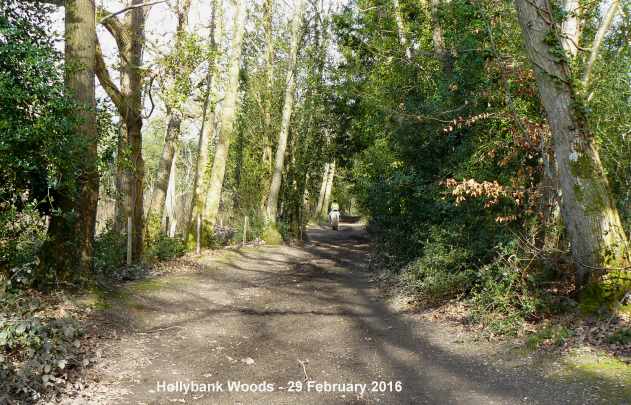
Birds were singing
well, especially Robins which were everywhere. I also
heard Dunnock, Wren, Blue Tit, Great Tit, Chaffinch,
Song Thrush, Nuthatch, Carrion Crow, Woodpigeon and
Collared Dove. A Great Spotted Woodpecker was
drumming near the southern entrance to the woods.
At least two Buzzards were constantly calling
overhead; they will be breeding in the woodland.
Coppicing work is continuing by the local conservation
group on the east side of the main path, creating a
lovely open space for flowers and other wildlife. The
completed coppicing on the west side of the path is
now sprouting well from the bases.
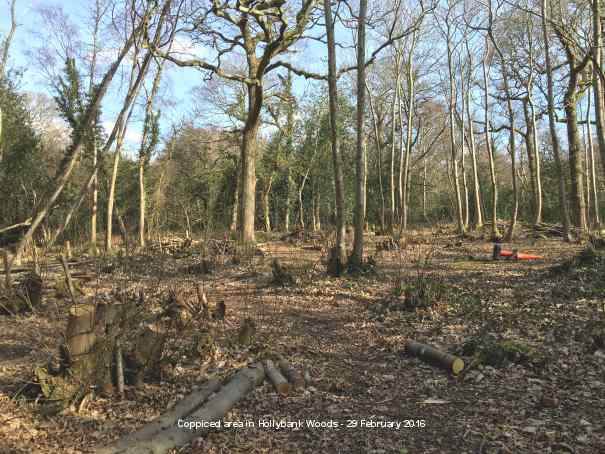
The Holly Lodge
clearing was really warm in the sunshine with
Daffodils and Primroses flowering nicely. These are
not the wild varieties, but escapes from the garden
that used to be here. A cluster of feathers from a
Sparrowhawk kill was beneath one of the Yews. With
temperatures rising I was really hopeful for a
butterfly, possibly Brimstone, but alas, I did not get
one.
I was most impressed with the newly laid Jubilee
hedgerow which I had not seen before. The hedge has
been extended to create an enclosure with several
access points through gaps in the hedge.
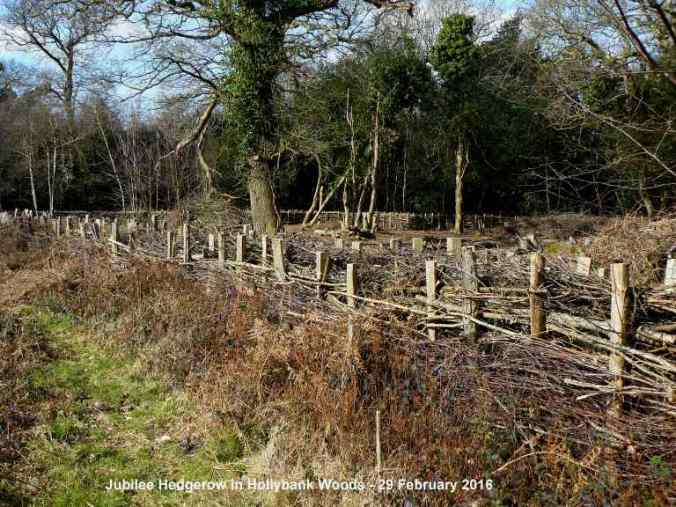
Things that caught my
eye as I went round the woods included the bright
green Holly leaves and the much lighter green
tufts of a Feather Moss.
On the north eastern
path near the Emsworth Common Road I found masses of
fresh Bluebell leaves, portending a good
display in a month's time, hopefully. Also along this
path were tufts of the smooth rounded leaves of
Soft Rush.
Towards the end of my
walk I came across a tree growth curiosity which I
occasionally see where two trees have grown to
maturity in very close proximity to each other. In
this case it was an Oak and a Beech close together to
the east of the main path.
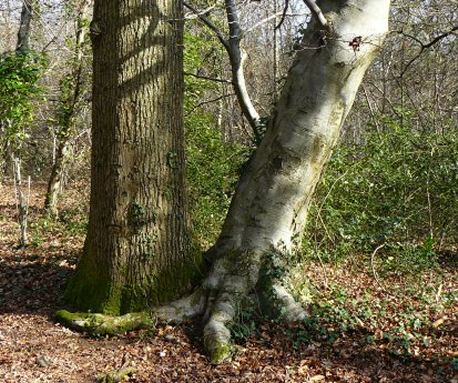
Brook
Meadow
Malcolm
Phillips spent time on the meadow today and got some
good sightings. Best of all was probably a Red
Admiral - surprisingly the first butterfly
recorded on Brook Meadow in 2016. Malcolm also got
what I think is a Drone Fly - another first,
though these, like Red Admirals, are seen all the year
round.
On the bird front
Malcolm saw 2 Grey Wagtails and 2
Goldcrests by the south bridge.
Finally, Malcolm put
together this montage of three Lesser Celandine
flowers to demonstrate their varying petal
formations.
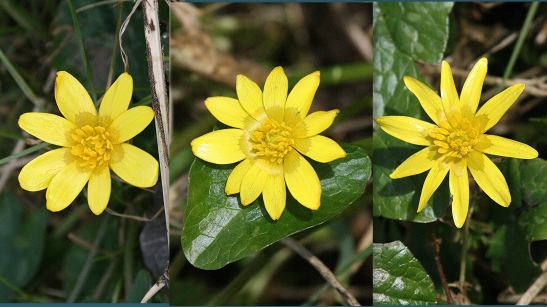
Surprise
Spoonbill
At 2:10pm
Peter Milinets-Raby saw a Spoonbill flying north along
the Lovedean to Clanfield road (by Catherington
Down).
He says, "It
was ungainly (longer wings, neck outstretched) flying
close and behind a single Little Egret. What an
unusual sight. No idea where it was heading, but it
will obviously follow the egret to a quiet spot along
the Meon Valley or perhaps further north to Alresford
Pond. It would be nice if this was found by another
birder!"
Langstone
Mill Pond
Because of
this strange piece of luck Peter decided to pop down
for an hour to Langstone Mill Pond later in the
afternoon at 3pm. He walked in via Wade Lane.
The highlights were as follows: The only birds of note
along Wade Lane were a male Pheasant, 14 Goldfinch, a
Stock Dove and 2 full summer Med Gulls flew over
calling as they headed inland!
At the flooded horse paddocks were 68 Teal (they had
all left by 3:45pm - heading off to roost somewhere on
North Hayling or further), 24 Moorhen, 2 Pied
Wagtails, 2 Stock Doves, 2 Mistle Thrush and dropping
in briefly for literally two minutes were 4 Water
Pipits. Well, what a surprise. They alas soon
moved on and headed west towards Southmoor and
beyond.
On the Pond: Just the 2 aggressive Mute Swans
The Grey Heron colony: Well, surprise, surprise
Nest 6 had a Grey Heron sitting on it, so completing
occupancy on all eight nests. The nest was tiny and
the Heron was huge sat on it. This nest will need
building up!! The single huge chick in the top of the
Holm Oak was again very noisy, especially when the
adults flew in with food!
Off shore (high tide) were 11 Wigeon, 3 Shelduck, 3
Great crested Grebes and 4 Red breasted Merganser. And
on the "island" in the middle of Sweare Deep were 55
roosting Curlew, 23 Grey Plover, 80+ Dunlin and 52
Oystercatcher.
In the distance off Conigar Point were 2 female
Goldeneye and 52 Shelduck.
SUNDAY
FEBRUARY 28 - 2016
Millpond
News
I had a walk
round the town millpond this morning. It was a fine
morning, but for a chilly easterly wind. The new Mute
Swan pair was lording the pond with not another swan
in sight, but seemingly taking no notice of the
accumulation of twigs and other potential nesting
material in the far north-east corner by the bridge.
It will be interesting to see if they do try to build
a nest which I assume this pair have not done
before.
Meanwhile, over on Slipper Millpond four Cormorants
were ensconced on the centre raft. More interestingly,
a pair of Great Black-backed Gulls were
snoozing on the south raft. These will be the regular
nesting pair staking out their territory for another
nesting attempt, though I suspect they will soon move
to the centre raft where they usually nest.
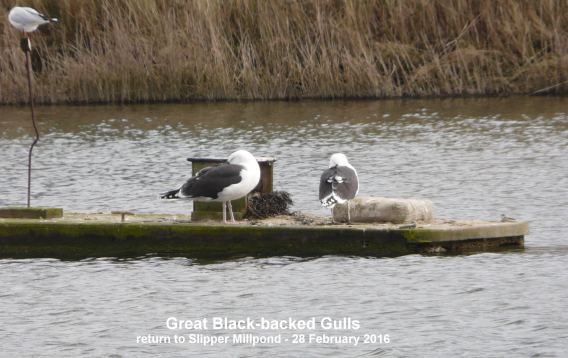
Just one of the pair
of Mute Swans that I saw yesterday on Peter Pond was
present today. It looked reasonably settled, so
hopefully we should soon see some nest building.
Brent
Geese on the move
While walking
along the millpond seawall, I could see and hear
hundreds of Brent Geese (500+) in the main channel in
the eastern harbour, chattering away, with many
washing and preening. This was by far the largest
flock I have seen in Emsworth Harbour for several
weeks. Here is a shot of a small section of them.
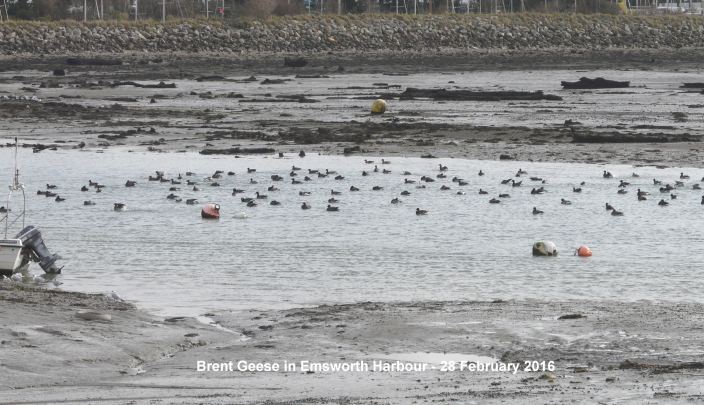
I recall having seen
large flocks of Brent in the harbour at this time of
the year in previous years and have assumed they are
birds passing through on their way towards their
breeding grounds in the Arctic.
Marsh
or Willow Tit - the last word?
Concerning the
photos taken by Mike Wells at the Queen Elizabeth
Country Park on Feb 26, Peter Milinets-Raby is fairly
certain they show a Marsh Tit and not, as Mike had
hoped, a Willow Tit. Peter says the critical feature
is a white pale spot, which one can see on all Mike's
photos, at the base of the bird's upper mandible.
Peter gives the following link to a BTO video for help
in separating these two species. See . . .
http://www.bto.org/about-birds/bird-id/telling-apart-marsh-and-willow-tits
. Another feature of Mike's photos supporting the
Marsh Tit identification is the slightly forked tail,
whereas the Willow Tit's tail is more rounded and
often straight edged.
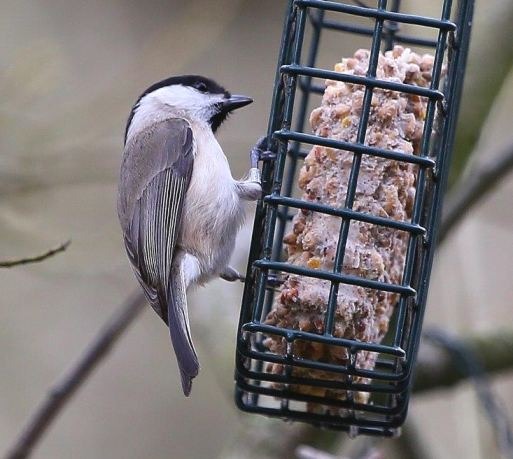
Steve Hooper, who used
to work at QECP and its various satellite woodlands
before he joined the Environment Agency, is also sure
Mike's bird is a Marsh Tit. He says they were seen
regularly in the QECP woodland when he was there, but
never Willow Tits. Steve says the last pair of Willow
Tits to breed in the area was in about 1985 or 1986
when a pair bred on the south-west side of the valley
at Oxenbourne Down. Sorry, Mike!
Green
Woodpecker
Patrick Murphy
had this magnificent male Green Woodpecker in his
garden this morning. A regular visitor. Patrick is a
lucky chap. It spent about half an hour aerating the
lawn probing with its large beak searching for ants
and insects.
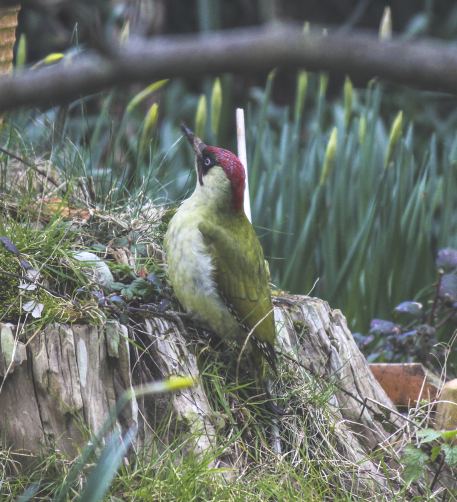
Bosham
delights
Barry Jay had
a walk around Bosham harbour today and got a couple of
really nice photos of local birds. Curlew in the reeds
and a Little Egret. Barry added, "I feel, we are truly
fortunate to have the resident breeding colonies of
these majestic birds on our doorstep."
SATURDAY
FEBRUARY 27 - 2016
Swans
back on Peter Pond
I was
interested to see what was clearly a pair of Mute
Swans swimming around on Peter Pond when I went past
this afternoon. It is likely they were prospecting for
a possible nesting site.
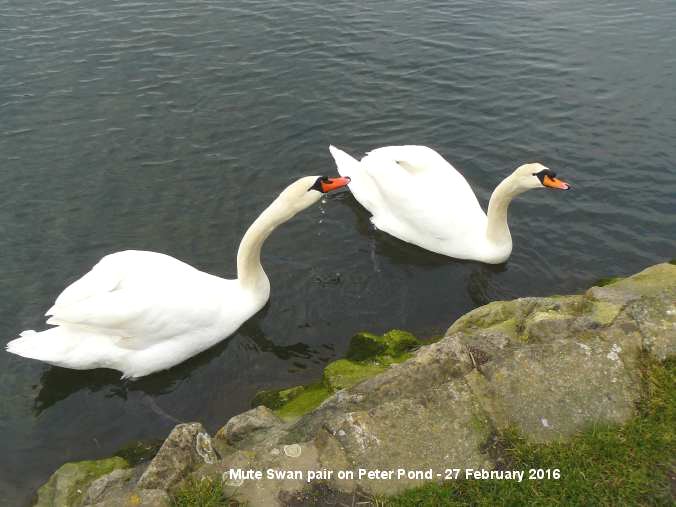
We have had nesting
swans on either Peter Pond or Slipper Millpond
(sometimes both) for many years, with varying degrees
of success. On Peter Pond, traditionally, the nest was
built on the island near the main road, though this is
a very exposed position and often led to casualties.
For the past few years a pair of Mute Swans, including
a 'Polish' variety pen, has nested in the reeds on the
east side of Slipper Millpond with mixed success. Last
year I am fairly sure the Polish pen of the pair was
killed in a fight after straying into the territory of
the nesting pair on the town millpond; the cob
remained on Slipper Millpond for several weeks without
its mate, but then went. It is possible that the cob
has now returned to the pond with a new mate; however.
the new pen is not a Polish bird as it has normal
black legs and feet. We shall wait and see how things
develop.
Marsh
or Willow Tit?
Mike Wells
provided two more photos of the Marsh/Willow Tit that
he took in the Queen Elizabeth Country Park yesterday
hoping that it might help to establish the bird's
identity - as a Willow Tit! Personally, I have nothing
to add to my comments on Mike's photo in yesterday's
blog. I am inclined towards Marsh Tit, but I am
definitely no expert on these birds! The winter
distribution map for the Willow Tit on page 298 of the
new Hampshire Bird Atlas also raises doubts about
Mike's bird as it shows no sightings in the Queen
Elizabeth Country Park area.
Water
Vole reintroduction
Following the
demise of the Water Vole population on Brook Meadow I
was interested to read that last year 190 animals were
released within the South Downs National Park. This
was the third year of a successful project to return
Water Voles to the River Meon in Hampshire which has
already seen the animals successfully breed on other
release sites further down stream. The 190 water voles
were released near Soberton, and joined 450 previously
released at Titchfield Haven in 2013 and 600 released
further upstream in 2014. Evidence, collected by a
team of volunteers monitoring latrines, shows that
they are breeding at every release site with some
animals breeding 2km further upstream.
For more information go to . . https://www.southdowns.gov.uk/water-voles-reach-south-downs-in-largest-uk-reintroduction-programme/
If the Water Voles do
not return to Brook Meadow then maybe we should press
for a reintroduction? As a reminder, here is a photo
of probably our last Water Vole on Brook Meadow on 23
April 2015 by Malcolm Phillips. For the history of the
Water Voles on Brook Meadow along with lots more
photos go to . . . Water
Voles
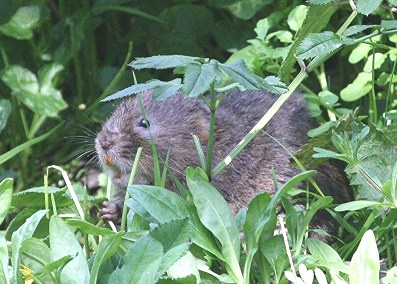
Snoozing
Fox
Christopher
Evans spotted this fox on the east bank of the tidal
section of the Langbrook stream. Christopher says,
"Obviously
not as asleep, as I had initially thought, as you can
see that the/she was keeping a watchful eye on me and
subsequently moved quickly, when I went up the bank
too get a closer shot."

Cams
Hall
Heather Mills
reported on this morning's walk by the Havant Wildlife
Group
"On
a cold morning with a brisk easterly wind 8 set off to
see the delights of Cams. I shall start with the
plants in flower for a change. Red Dead-nettle,
Celandine, Cherry-plum, Dandelion, Butcher's Broom. We
paused to look over the bridge at a close Greenshank.
Further up the footpath there were sightings of one or
two Redshank. Whilst the groups of Wigeon numbered in
dozens both sides of the creek. Teal with small flocks
of Black-headed gulls and Mallards. We had a very long
look at a male Goldeneye which was feeding in the
middle of the creek, together with another male which
ventured closer to shore, with one female. One distant
Kingfisher across on a sluice, with another seen by
one member later on. Six Little Grebes in the lower
end of the creek were joined by others busily diving.
Birds singing were Blue & Great Tits with
Goldfinch and Greenfinch. The Brent Geese were evident
towards the Portchester end of the creek flying about
as the tide changed. 36 species seen with both Green
and Great Spotted Woodpeckers, the latter seen
drumming.
On a
sad note, I have read that Richard Hedley had passed
away in January, and as a group would like to send our
condolences to Jean. Richard guided our group around
Browndown in the distant past and shared his wealth of
knowledge in talks that we attended."
FRIDAY
FEBRUARY 26 - 2016
Marsh
or Willow Tit?
Mike Wells got
a photo of what he thinks could be a Willow Tit on a
feeder in the Queen Elizabeth Country Park. Or is it a
Marsh Tit? Separating Marsh and Willow Tits is one of
the most difficult identification tasks in birding,
and I certainly am not going to stick my neck out on
this one. However, Mike's excellent photo shows the
features well, so I am hoping someone with more
experience of these birds than me can provide an
answer. Mike points out that the bird has a metal ring
on its right leg.

The books say that
Marsh Tit has a glossier black cap and a smaller black
bib than Willow Tit, but that is not an awful lot of
help unless one sees the two birds together. My book
also says the Willow Tit has a pale panel on its
closed wing, which Mike's bird does not have. This
inclines me towards Marsh Tit. If in doubt over
identification, my policy is always go for the most
likely one, which in this case is Marsh Tit, a fairly
common woodland bird, but Willow Tit is rare. However,
all the experts agree the best way to distinguish
these two birds is by their call and song, though even
that is far from straight forward!
Robin
goes fishing!
David Taylor,
who lives in Dumfries and Galloway, was amazed to see
a Robin catching a fish from an outside tank. The
Robin flew down to the tank and watched the fish
intently. It then jumped into the water and
successfully caught one of the fish and proceeded
shake and bash it against the edge of the tank. After
this the Robin went under the tank to consume its
prey. For a full description and photos go to . . .
http://bto-enews.org/NXK-41HZJ-3UEDCR-1ZY88T-0/c.aspx
Has anyone ever seen anything like this?
THURSDAY
FEBRUARY 25 - 2016
Brook
Meadow
I had a walk
through Brook Meadow this morning. Chilly but bright
sunshine with birds singing everywhere, particularly
Robin and Wren. From the north path by the railway
embankment I could hear and occasionally see two
Buzzards soaring high to the north of the meadow -
birds from the Lumley Mill Farm colony, maybe?
One of the conservation volunteers (Phil) was working
at the north-east corner using his bow-saw to remove a
small tree stump that had he had not managed to do at
the last workday.

I also met Malcolm
Phillips on the main river path; he had not seen much
apart from the usual Kingfisher and Goldcrest - good
enough return for most people I would suspect!
Malcolm also got a
shot of one of the Buzzards that I mentioned earlier.
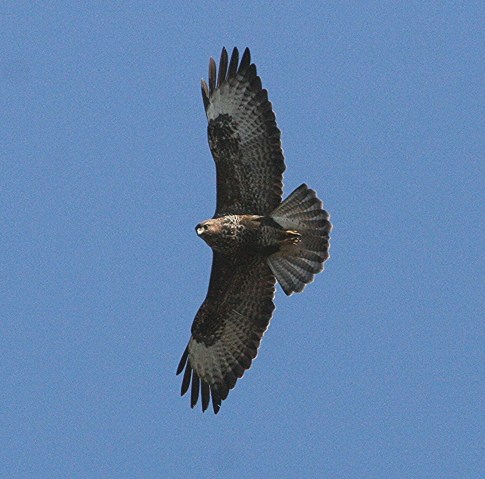
However, Malcolm
missed the Cormorant which I saw flying down
onto the river. This may well have been the bird that
Ros Norton saw yesterday north of the north bridge
with a fish in its bill. The river is running very
high at present, thus allowing the Cormorant to fish.
Thinking back, I do not recall ever having see a
Cormorant fishing in the River Ems before. I tried to
get a photo, but the bird was moving very quickly, so
this is my best effort.
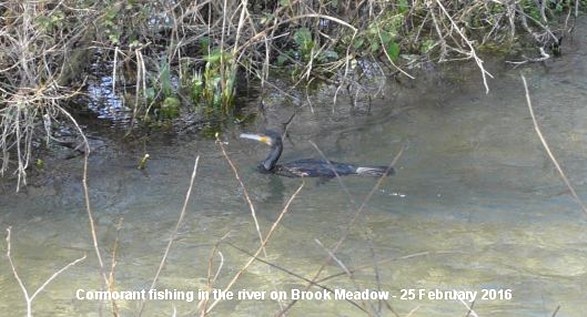
I wandered over the
wet Lumley area on the east of the meadow where fresh
leaves of Greater Pond Sedge were emerging in
profusion, but there was no sign of any brown
spikelets. As I noticed last year, this plant is
rapidly spreading onto the main Lumley area,
previously it was largely confined to the areas close
to the stream.
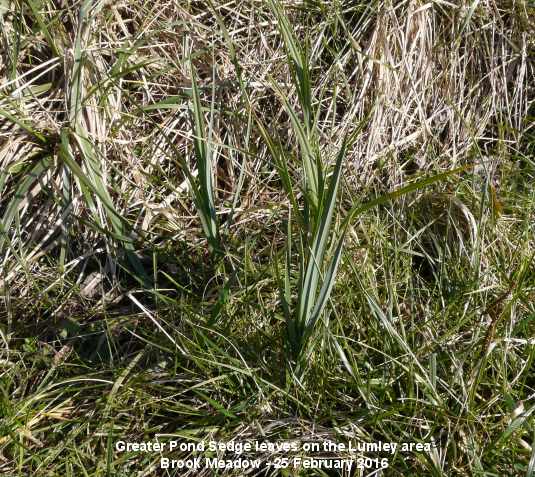
Langstone
Mill Pond
Peter
Milinets-Raby popped down to Langstone Mill Pond this
morning from 10:08am to 11:41am - tide pushing in to
high tide.
Langstone Mill Pond:
The single Grey Heron chick from the Top Holm
Oak nest was very vocal this morning, constantly
calling to one of its parents for food. As you can see
from the photo the adult ignored it! Other chick
noises were heard from the Lower Holm Oak nest, but
the foliage is too dense to see anything.
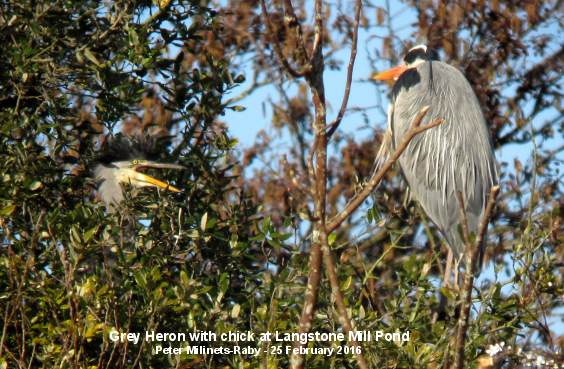
Also on the pond were
2 very aggressive Mute Swans - given half a chance
they would grab one of the dogs that tease them and
pull it in the water and drown it!
Also seen was a flash of blue as a Kingfisher dashed
across the pond, a Water Rail briefly slinked along
the edge of the reeds before slipping out of sight, 2
Long-tailed Tits were moving through the spring
blossom and a pair of Siskin were in the Alders at the
rear of the pond.
Flooded Horse paddock: 23 Wigeon preferring to feed on
the grass rather than the low tide shore. Also present
were 1 Grey Wagtail, 22 Moorhen, a single
Oystercatcher and just 2 Teal (the rest were feeding
offshore on the mud as it covered over).
Off shore: 44 Teal, 25 Shelduck, 82 Dunlin (which soon
moved off towards Thorney Island), 203 Brent Geese, 2
Common Gulls, 12 Lapwing and 2 Grey Plover.
Out on the rising tidal waters of high tide were a
pair of Goldeneye and a female Red Breasted Merganser.
And way in the distance off Conigar Point were 7
Shelduck.
With the warm sunshine, the morning did have the air
of late winter, with stuff leaving. It is only a
matter of days before the first true migrants arrive,
especially as the nearby High pressure slips onto the
continent giving us some interesting weather
conditions for the weekend and early next week! Med
Gulls heard several times, but not seen.
Swan courtship
Christopher Evans got an excellent image of a pair of
Mute Swans doing their classic courtship display at
Langstone. Something I have not see this year as yet.
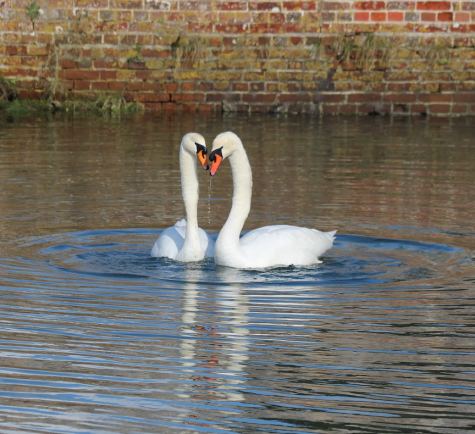
WEDNESDAY
FEBRUARY 24 - 2016
Canoe
Lake, Southsea
I had to take
Jean into Southsea, so while I was there I had a look
at Canoe Lake where I used to do regular weekly bird
counts in the 1990s and 2000s. It was very good to see
a reasonable flock of 43 Mute Swans on the
lake. At the end of my regular counts in 2003 numbers
had dropped off dramatically probably due to the
banning of feeding. I also had 51 swans on the lake at
this time last year, so they are clearly back. For
more details of my counts at Canoe Lake see . . .
Canoe
Lake, Southsea
I was also interested
to see the Shag which several people have
previously reported and photographed. It was swimming
and fishing at first and then got onto the boats. It
was really good to get a good view of the Shag which
one generally only sees on choppy seas. The Shag is a
much sleeker bird in the water than the larger
Cormorant and gives a little jump before diving. When
perched its steeper forehead becomes much clearer. The
photo shows a brownish overall plumage and slightly
pale underparts which suggests it is an immature bird,
though probably not a first winter. Full adult plumage
is not attained until the third winter.
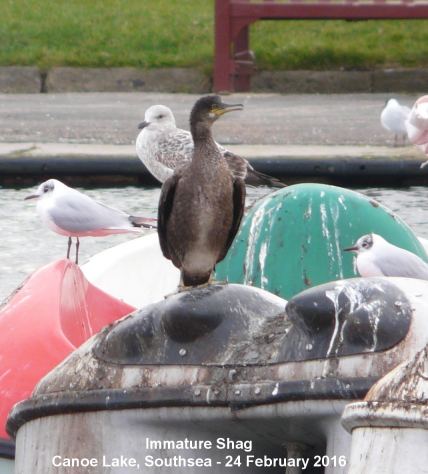
Baffins
Pond
I stopped
briefly at Baffins Pond on the way home. I walked
round the pond, where a pair of Mute Swans was on the
pond and another pair (probably driven off) was on the
grass to the south of the pond. A bit like Emsworth
Millpond. Tufted Duck were particularly numerous
(60+), but very few Shoveler (I only saw 4). A fine
grey-headed Cormorant was on the island, while
male Feral Pigeons were busy displaying to potential
mates by puffing out their chests and flattening their
tails.
First
bird songs
While at Canoe
Lake I heard my first Chaffinch song of the
year from one of the trees. Last year I heard my first
full Chaffinch song on Brook Meadow on Feb 20.
Also, I heard my first Blackbird song of the
year at dusk from a neighbour's garden, which is a
little later than usual. In the last two years I heard
the first Blackbird song on Feb 15 and Feb
16.
Langstone
Mill Pond
Peter
Milinets-Raby popped down to Langstone Mill pond late
this morning 10:50am to 12:07pm. The highlight was
discovering that an eighth Grey Heron nest is
being built by two adults. Its location is behind the
top Holm Oak nest and can only viewed from the flooded
horse paddock gate at the start of the path that leads
to Wade Lane. Also observed from here was the top Holm
Oak nest that only contained one very huge looking
chick that was noisily begging for food when the
adults flew in. The lower Holm Oak nest had noisy
young calling but nothing seen through the thick
foliage. Nest seven has an adult bird sitting already!
Nest 5 was occupied by two adults that were displaying
and fiddling with sticks. The male of this pair had
flushed, blushed red legs. Very impressive. All other
nests occupied, except for nest 6 which has still not
attracted last year's pair. Last year they were the
last to start breeding, so it is no surprise that this
nest is empty.
Also on the pond were the very aggressive Mute Swan
pair, a Kestrel, a Green Woodpecker and briefly a
Water Rail swam across from one reed bed to another.
It was heard singing twice.
In the flooded horse paddock were 23 Wigeon, 1
Oystercatcher, 79 Teal, 19 Moorhen, 1 Little Egret and
3 Grey Herons collecting sticks.
High tide off shore. Just caught the last metre of mud
being covered containing 30 Dunlin and 21 Lapwing.
Also seen were 6 Brent Geese, 3 Calling Mediterranean
Gulls flying over, 8 Teal, 1 Shelduck and a Great
Crested Grebe.
In the distance off Conigar Point were 17 Shelduck, 5
Red Breasted Mergansers, a female Pintail and another
Great Crested Grebe.
Of interest I noted this afternoon that one pair of
Lesser Black-backed Gull were on the Colt factory roof
off New Lane Havant, plus a prospecting pair of Great
Black-backed Gulls!!! At least 12 pairs of Herring
Gulls! Numbers will grow as spring takes
hold.
Tony's
gallery
Tony Wootton
spent a lovely warm (Spring is coming!) day at the
Burgh, which is just East of Arundel. He saw a dozen
Red Kites and 6 Buzzards, including some repeats.
Other birds seen included Grey Partridge, Skylarks,
Corn Buntings, Linnets, 2 Ravens, and one Short-eared
Owl. Also, a very elusive Brown Hare and Tony's first
butterfly of the year, a female Brimstone.
Southsea
Castle
Barrie Jay
captured this excellent image of a Rock Pipit at
Southsea Castle today. He says 5 Purple Sandpipers
were also present.
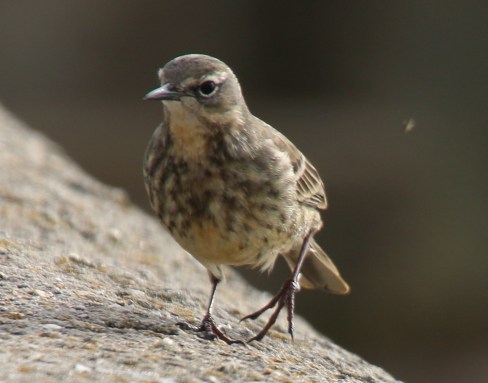
TUESDAY
FEBRUARY 23 - 2016
Local
observations
Collared Dove
and Woodpigeon were singing almost in harmony in
Bridge Road car park, with Robin and Wren adding their
soprano voices.
Also along Bridge Road, I spotted a small plant of
Petty Spurge growing out of a crack in the
pavement, not in flower as far as I could see, though
the flowers are normally very inconspicuous. This
plant can flower all the year round. It is not a
native plant but it has been here a long time.
Officially it is called an archaeophyte (an ancient
introduction) and has been recorded as a casual garden
weed, brought in with garden plants from
Italy.
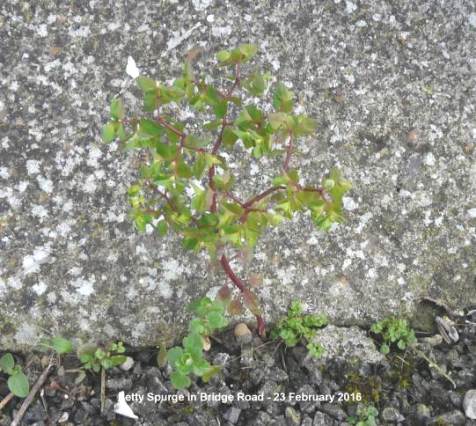
I had a quick look at
the wayside north of Emsworth Railway Station, but it
was very wet and muddy so I did not go on it. I gather
from Andy Brook that it will soon be cut, so that is a
good thing.
The Black Spleenwort ferns are still growing on
the garden wall outside house 90A North Street just
before the entrance to Emsworth Railway Station.
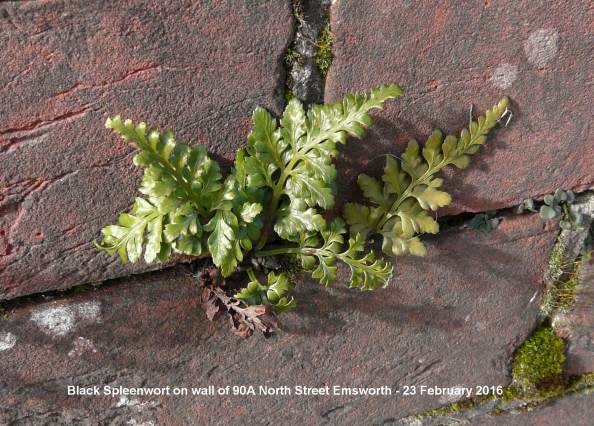
Malcolm's
gallery
Malcolm
Phillips got excellent images of Goldcrest and female
Kingfisher both in the garden of Gooseberry Cottage.
Sparrowhawk
Barry Jay had
what he described as a 'beautiful but deadly' male
Sparrowhawk on his garage roof in Waterlooville today.
Barry's cracking photo shows well the barred rufous
underparts which distinguishes the male Sparrowhawk
from the larger female which has finely barred, pale
underparts. Just look at those talons!
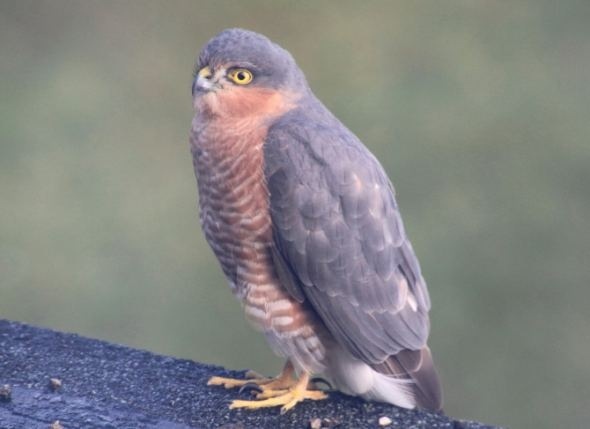
MONDAY
FEBRUARY 22 - 2016
Millpond
News
There is not
much to report from this morning's constitutional
around the town millpond in a constant and wetting
light drizzle. There was no sign of the lone swan
under the grill on the corner of St James Road; I
assume the RSPCA have moved it as I reported
yesterday, but to where? The new dominant pair of
swans was near the Slipper Mill Sailing Club
buildings, though there was no sign of any other swans
in the harbour for them to be concerned about.
Here are a couple of very ordinary wild flowers that I
snapped on the edge of the millpond along Bath Road,
ordinary, but with a beauty all of their own.
Shepherd's Purse (decorated with raindrops) and Red
Dead-nettle.
Spotted
Redshank
I popped over
to Nore Barn at about 14.15 this afternoon on a
falling tide mainly to check on the health of the
Spotted Redshank which I had not seen for a couple of
weeks. I found it looking perky as always and feeding
in the stream, but all alone. In fact, there was
virtually no other birds visible in the harbour, but
for a few gulls and Oystercatchers. Have they already
left for their summer quarters? From my previous
records, the Spotted Redshank should be with us for a
little while yet, but there is no telling in this very
unusual winter. Last year's final sighting was on Mar
20, 2015.
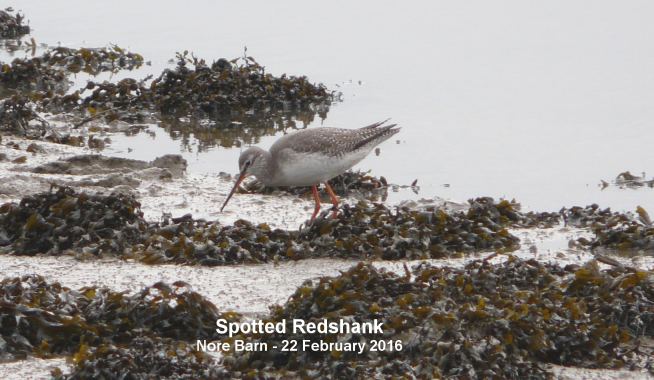
'Polish'
swans in Emsworth
I produced the
following summary of the history of Polish swans in
Emsworth in response to a request for information from
Moss Taylor in the current issue of the BTO News. Moss
intends writing a paper on the subject for British
Birds and would like to present the results at this
year's BTO Swanwick conference in December.
Polish
swan showing the distinctive pink legs and
feet

2004 - Peter Pond -
Pair nested. Pen was Polish. Five cygnets were
produced, including 2 'Polish'. All survived.
2005 - Peter Pond - Pair nested. Pen was Polish. Five
cygnets were produced, including one 'Polish'. Four
survived, not the 'Polish'.
2006-2007 - No nesting, but Polish swans occasionally
sighted on ponds and in harbour.
2009 - Slipper Millpond - Polish pen swan attempted to
nest. Laid eggs. Nest failed
2010 - Slipper Millpond - Polish pen swan nested.
Produced 3 cygnets including one Polish. All
survived.
2012 - Slipper Millpond - Polish pen swan nested - 5
eggs. No cygnets.
2013 - Slipper Millpond - Pair with Polish pen - 8
eggs but late. Failed.
- Emsworth Marina - Pair (both normal). Produced 3
cygnets including one Polish
2014 - Slipper Millpond - Pair with Polish pen nested
and produced 7 cygnets 2 of which survived. Neither is
Polish.
2015 - Slipper Millpond - Pair with Polish pen back on
territory (Jan 25). Polish pen presumed killed in a
fight after straying into the territory of a nesting
pair on town millpond (Mar 25). Cob remained on
Slipper Millpond for several weeks without its
mate.
The town millpond pair (neither Polish) produced 8
cygnets including 2 Polish. Three cygnets lost to
Herring Gulls including one of the Polish cygnets. The
surviving Polish cygnet fledged and I assume went off
successfully.
The
swan family on the town millpond in May 2015 with two
white cygnets
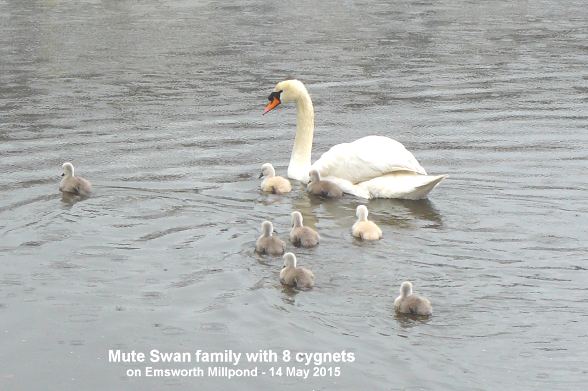
More
information on the Polish Swan
The Polish
mute swan is a 'pure white' version of a Mute Swan.
The legs and feet are a pinkish-grey colour instead of
the usual black colour. A pigment deficiency of a gene
in the sex chromosomes is what causes the whiteness.
When a female Mute Swan inherits only one
melanin-deficient chromosome she will be a Polish
swan, whereas the male of the same parents will be
normal. If the next generation is produced by two of
their offspring the brood will contain numbers of both
Polish and normal cygnets of either sex.
Polish swans were given their name when they were
imported from the Polish coast on the Baltic sea into
London around about 1800. They were mistakenly thought
to be a new species and were given the name 'Cygnus
immutabilis' (ie Changeless Swan). Polish swans have
white down as cygnets and hence do not change colour
from brown to white like regular cygnets as they reach
maturity. Polish swans are not a different species of
swan, because they are mute swans.
SUNDAY
FEBRUARY 21 - 2016
Millpond
Swan saga
I went down to
the town millpond this morning to check on the swan
situation. The new dominant pair were still up to
their tricks near the small wall by the Slipper Mill
Sailing Club, defending their newly won millpond
territory from invasion by another Mute Swan pair that
were in the harbour immediately outside the wall. This
has been a fairly regular high tide activity over the
past week or so.
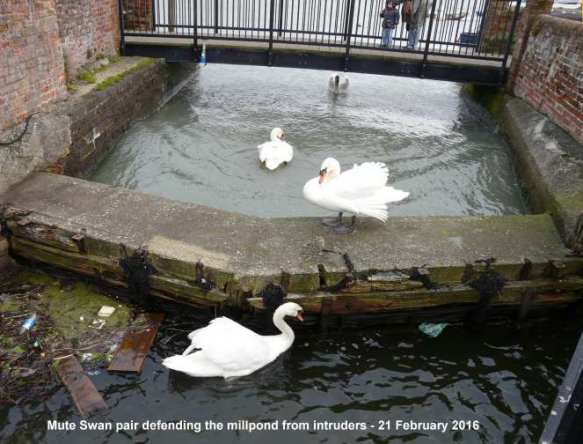
As for the lone swan
that has been held captive in the millpond culvert for
past few weeks by the dominant swan pair, I gather
that the plan mentioned in yesterday's blog has been
carried out. The Environment Agency did remove part of
the grill on the corner of St James Road allowing the
RSPCA Rescue Officers to capture the swan which
apparently they moved to the relative safety of the
Westbrook Stream at the back of Bridge Road car park.
I was surprised to hear this as I would have expected
the officers to have moved it into the harbour, well
away from the millpond. This fact needs confirmation.
There was certainly no sign of the swan in the stream
this morning.
Malcolm's
gallery - Brook Meadow
female Blackbird
feeding on Rowan berries . . . . . . . . . female
catkin on a Goat Willow tree
SATURDAY
FEBRUARY 20 - 2016
The
swan saga
When I walked
past the grill at the end of St James Road this
morning I found three Environment Agency chaps and two
RSPCA Wildlife rescue men discussing how to get the
'trapped' swan out of the culvert. The swan was not
present at the time, though the RSPCA chaps were well
aware of the situation from phone calls. I spoke to
one of the RSPCA chaps who said there could be another
swan, possibly dead, in the culvert. However, EA did
not have the manpower to go into the culvert to
recover it. The RSPCA man thought the best way to
catch the live swan was for the EA to remove part of
the grill allowing the swan to move onto the stream. I
think this was the plan.
First
Daffodil
Malcolm
Phillips had a walk round the meadow this morning. He
saw nothing of special interest though a Daffodil just
emerging opposite the sluice gate caught his
attention. I think this is the first one on Brook
Meadow, though Daffodils have been out generally in
town and country for some weeks. They are always a bit
later on the meadow.
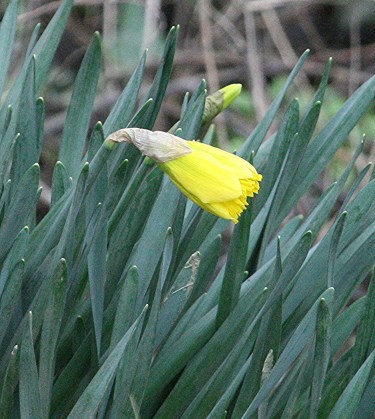
FRIDAY
FEBRUARY 19 - 2016
Langstone
Mill Pond
Peter
Milinets-Raby is in the middle of a major DIY project
so does not have much time to get out. However this
afternoon at 1:12pm he managed a very short visit to
Langstone Mill pond.
The highlight was discovering a seventh Grey Heron
nest located at the back of the trees and now the
furthest nest to the south. It is a huge stick nest
and very obvious and the two adults were adding to it
as I watched. Also five of the old six nests are
occupied and chicks were heard calling. Also on the
pond were 2 adult Mute Swans and 2 Teal.
In the horse paddock were 22 Moorhen, 2 Oystercatcher
and 56 Teal.
Off shore were 1 Greenshank, 12 Shelduck, a pair of
Goldeneye, 2 Red Breasted Merganser and 230+ Brent
Geese. And 1 Med Gull over.
Also seen briefly as I departed at 1:51pm was the
Water Rail creeping along the edge of the reeds at the
back of the pond.
THURSDAY
FEBRUARY 18 - 2016
Brook
Meadow
I went over to
the meadow for the regular Thursday work session. It
was not a bad morning weather wise, but very wet
underfoot and the river was running high. Just 6
volunteers turned up for work. The main job was to
continue clearing scrub from the north-east corner to
open the area up and make it less attractive to
vandals. A pity really as it is nice bird habitat, but
clearing excess scrub will hopefully encourage new
growth. Here is a shot of the group at work in this
area.
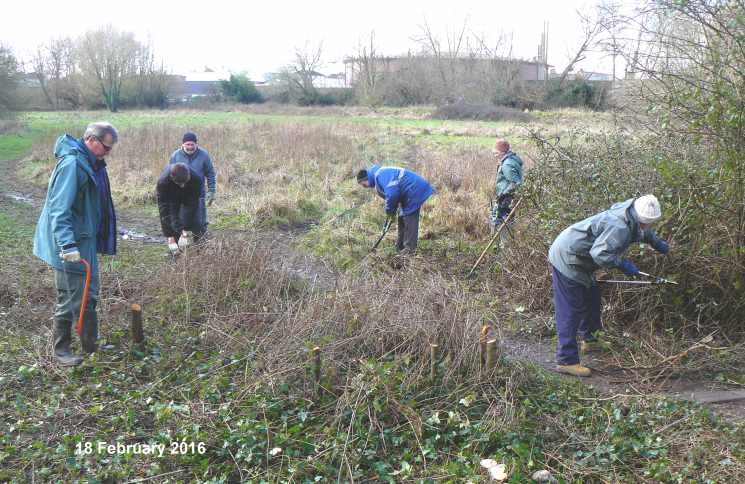
See the following link
for more details and photos . . . http://www.brook-meadow.hampshire.org.uk/bm-diary-current.html
Wildlife
observations
The volunteers
worked to a rich medley of bird song, notably from
Song Thrush, Wren, Great Tit, Dunnock and a Robin
which sang strongly from high up a small tree.
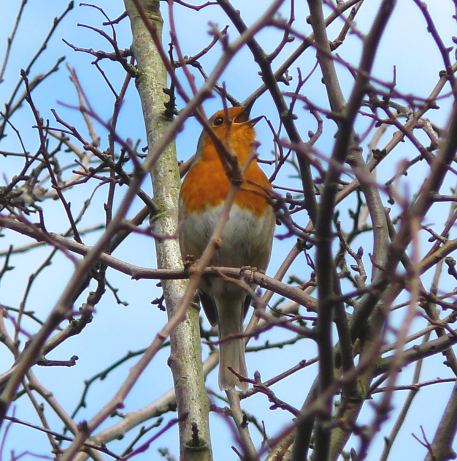
I had a walk round the
meadow to see what I could find of interest. Wrens
were singing everywhere. The leaves of Hard
Rush were standing up sharply in the orchid area
and in the wet Lumley area.
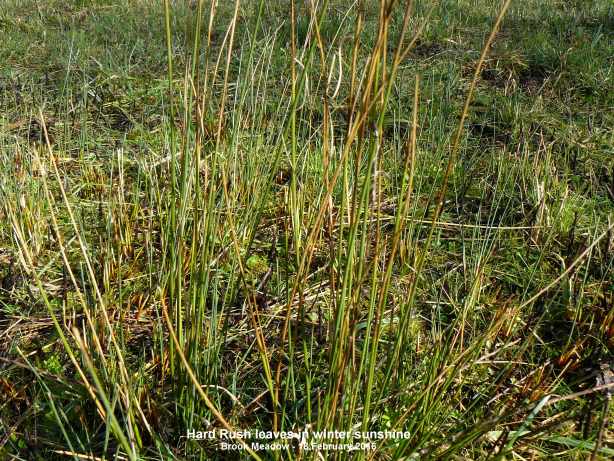
A good number of
Butterbur flower spikes are now up plus bright
yellow Dandelion flower, shining like a gem in
a sea of green grass.
Swan
news
The lone swan
under the grill at the corner of St James Road was
attracting quite a bit of attention when I passed this
afternoon. A lady who lives across the road told me
she had been feeding seed to the swan for the past 2
weeks and wondered if the authorities should be
alerted to move the bird. I said the bird looked in
reasonably good condition with no signs of injury.
Also, I had seen the swan emerge onto the pond from
the other end of the culvert, so it is was not trapped
under the grill. However, it is reluctant to move onto
the millpond by the aggressive attentions of the new
dominant pair of swans on the pond. I said I thought
it was likely to be one of the pair of swans that
nested on the millpond for the past 3 years, but which
had been ousted by the new pair. That unfortunately is
nature!
WEDNESDAY
FEBRUARY 17 - 2016
Swan
news
The lone swan
with a loose feather on its right side was under the
grill at the corner of St James Road when I passed by
at about 10am. Walking round the millpond I found the
dominant pair of swans in far south west corner of the
pond near the Emsworth Sailing Club. This is where a
pair of swans tried to nest many years ago, with no
great success from what I can recall. However, there
is some twiggy material there, so it is possible.
Their presence here rather than by the bridge confirms
for me that this is not the original nesting pair, but
a new pair. There is, in fact, a nice build up of
potential nesting material in the corner near the
bridge where the original pair have nested for the
past 3 years, but it looks as if it will not be used.
We shall see.
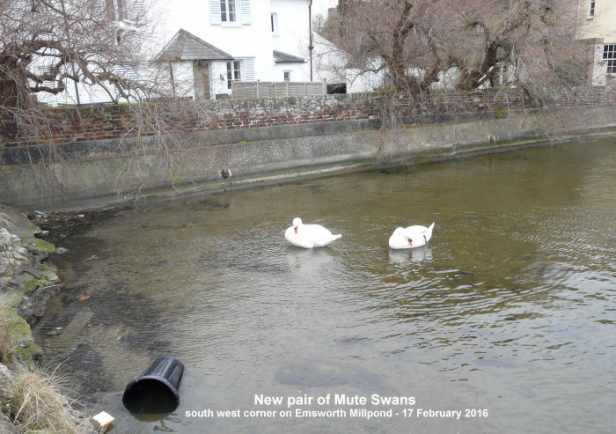
Malcolm's
news
Malcolm
Phillips had a wander around Brook Meadow this
morning. He found a Goldcrest displaying at the south
bridge and a Dunnock in full song, establishing its
territory. Most birds are getting frisky.
Magpie
gathering
Yesterday
morning Eileen Kendall saw 7 Magpies together in a big
tree in a neighbour's garden in North Emsworth. She
says, "Apart from the old meaning 'a secret never to
be told', do you know why they gather in such a
number? We usually see 1 or 2 and then their
youngsters later in the year, but never this number at
once."
In fact, it is not all that unusual to see gatherings
of Magpies at this time of the year. These spring
gatherings are apparently used to resolve territorial
conflicts and social standing. I found a picture on
the internet of 21 Magpies in a tree, which seems
pretty exceptional.
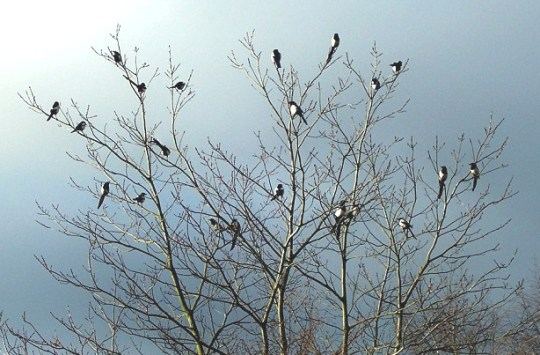
The gatherings are
called 'parliaments' and have given rise to nursery
rhymes and poems about Magpies, such as, the one
referred to by Eileen. Here it is in its entirety,
though there are variations.
One for sorrow,
Two for joy,
Three for a girl,
Four for a boy,
Five for silver,
Six for gold,
Seven for a secret never to be told,
Eight for a wish,
Nine for a kiss,
Ten for a surprise you should not to miss.
Colin's
news
Colin Vanner
got the chance to nip over to Titchfield Haven canal
path and got some excellent photos there. I am not too
hot on deer, but I think this one is a Roe Deer
growing its new antlers.
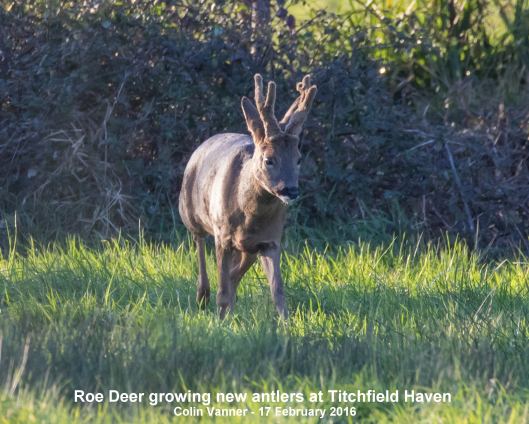
Colin says to see the
Barn Owl park in the car park at the top of the path
in Titchfield village and walk along the path for a
few hundred yards look to your right across the field
there is an oak tree with a split running up it its in
the top of the split.
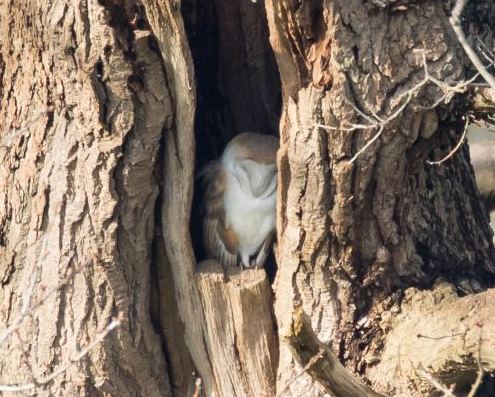
and a cracking
Redwing
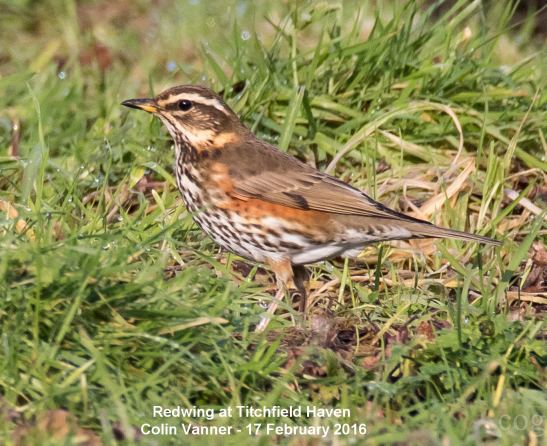
TUESDAY
FEBRUARY 16 - 2016
Garden
Egret
The frosty
weather brought a Little Egret up from the millpond
this morning to prospect for fish in the stream that
runs along the end of our garden. It usually perches
on our wall, but today it was on our neighbour's
Silver Birch tree.
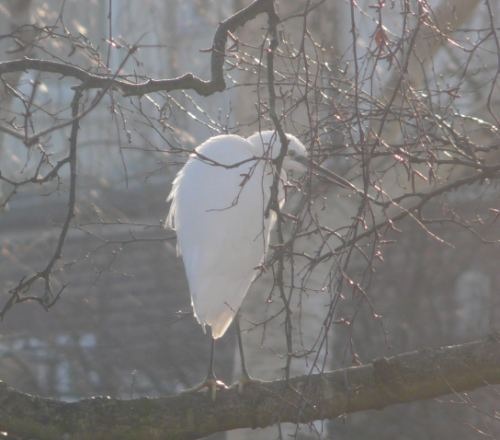
We also had a a very
active Goldcrest searching around the shrubs
and trees for insects or grubs. It never stopped
moving, so there was no chance of a photo, but it was
so good to see. My last sighting in the garden was in
November 2015, though we usually have a few sightings
each year in winter.
Wood
Mouse
John Arnott
saw a Wood Mouse at the northern edge of the back
track at Nore Barn Wood just before 17:00h today. John
says, "The
Wood Mouse was very confiding and was digging
successfully for food. Neither Philippa or myself
could see what it was eating even though I also took
some video footage of it. When a dog walker passed the
Mouse just dived into cover under the hedge a couple
of feet away. Once the dogs had passed it reappeared
even though we were standing only 6 or 7 feet away. I
thought it was worth a quick picture or two as I don't
often have the chance to observe them in the
wild."
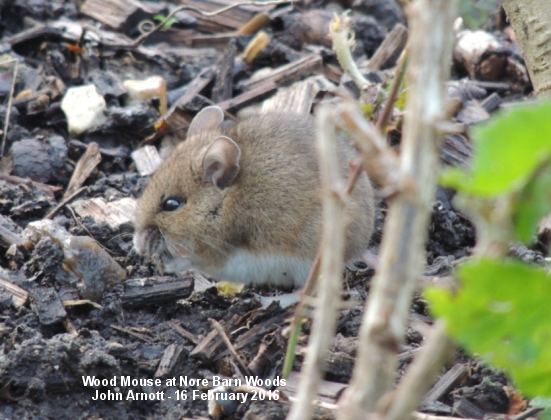
The Wood Mouse is easy
to identify from its large ears and big black eyes. It
is common in gardens and in sheds where it can be
somewhat troublesome! We had a family of them in our
garden shed last year and they made a nest behind a
workbench making holes in the wooden wall and piles of
wood shavings. They also nibbled garden gloves and
chair covers as well as bags of bird food before I
invested in some sturdy plastic bins to keep them out.
Short-eared
Owl
Tony Wootton
got an excellent photo of one of the Short-eared Owls
that have been wintering at Farlington Marshes. This
must be the winter of the Short-eared Owl surely. Tony
also got this all black Rabbit - unusual, though they
are seen from time to time.
Purple
Sandpiper
Leighton
Barrable was at Southsea Castle again today and got a
nice shot of one of the Purple Sandpipers standing on
a rock. They are usually here until early March. He
also spotted a Shag out at sea.
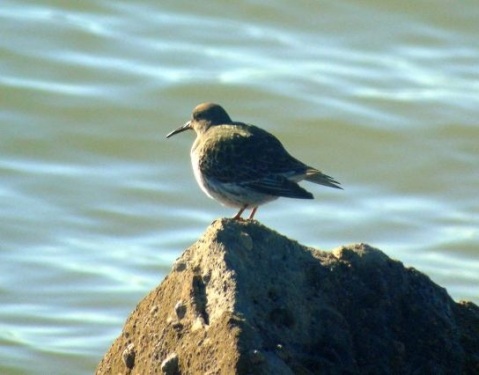
For
earlier observations go to . . February
1-14